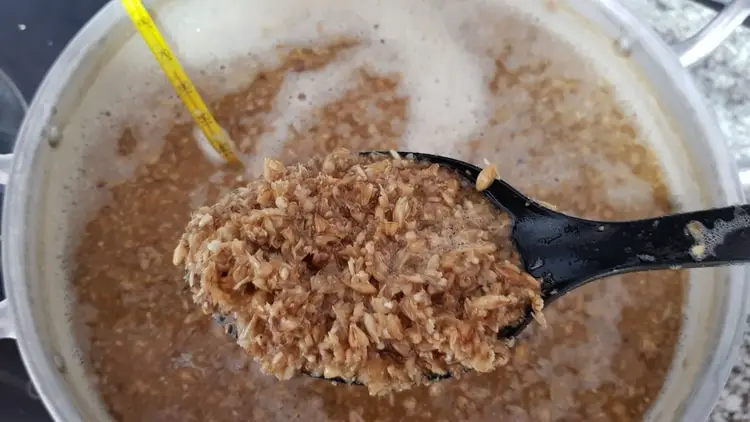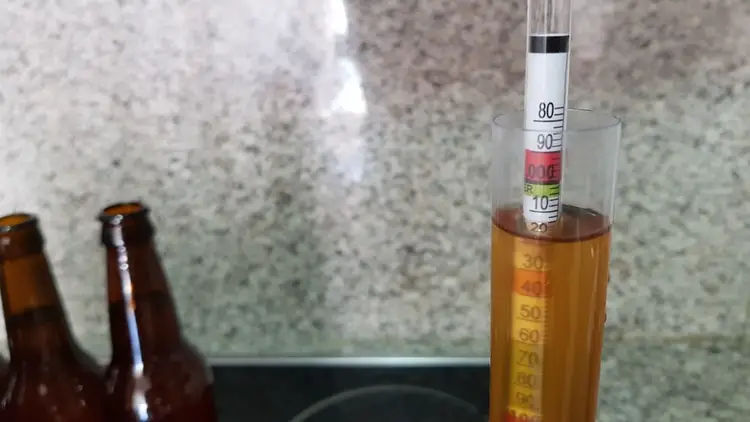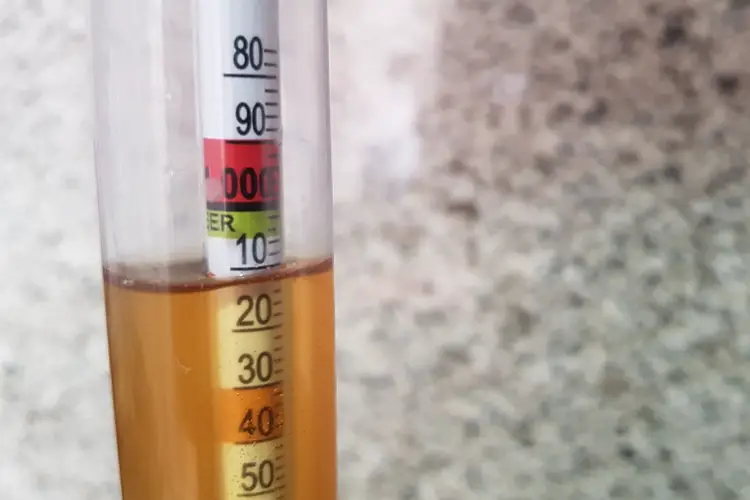Sometimes we worry about our beer fermenting well, and healthily. It can ferment too slowly or finish prematurely. There is a third issue, one which also perplexes, over-attenuation. Your beer’s final gravity goes lower than desired.
Over-attenuation is when beer ferments too aggressively. It dries out and its flavor profile is thrown out of balance. Stable temperatures, proper yeast handling and a stable mash and sparge (where applicable) keep the brewer on track.
Attenuation – A Quick Review
As beer ferments down from original gravity (OG) to final gravity (FG), we call this attenuation.
If a beer starts out at 1.048 OG we would want it to ferment down to about 1.010- 1.012 final gravity.
Beer normally attenuates at a rate of 75-80%.
This means that 75-80% of the sugars have been metabolized into alcohol and 20-25% are left to add sweetness and a balancing malt character to the beer.
Are Varied Attenuation Rates OK?
Yes, they are fine.
Keep your goals in mind when you formulate and execute a recipe. Your beer can ferment down a bit higher or a bit lower.
Consider these factors:
- First, what style are you brewing?
- What type of malt and what was the mash temperature?
- What yeast and what fermentation temperature?
- What are the specific style guidelines?
Causes of Over Attenuation
Beer Style
Style impacts attenuation and malt content affects your beer’s ability to ferment down.
If for example you brew a heavy Scotch Ale, like a Wee Heavy, you may use 10 lbs. of dark malt extract. You want it to have a real kick.
Dark malt extract will have a lot of adjunct malt, coloring and flavoring malts that may not be fermentable.
They will give a high OG, 1.075 but possibly a high FG. 1.018-.1.020.
This is typical of dark extracts as they will have a high melanoidin content. (compounds formed during kettle browning and the malting process). They add character but can also make a beer stick to the roof of the mouth sweet.
In this style of beer however, this profile may work, exceptionally malty with a subtle to neutral hop character.
On the other hand, a North German Pilsner would either use a light pale or Pilsen Malt, or extra light liquid extract.
The melanoidin content is low and even if the gravity starts at 1.042 – 1.046, it can finish at 1.004 – 1.006 and fall within the style, refreshing and delicious.
Dry (light, crisp mouthfeel), malty, and bitter is what you aim for.
Also, a Pils is a lager beer and ferment longer and cooler than an ale. So, a low attenuation is desirable, one that could be problematic in another beer.
Malt Profile and Mash Temperature

Even should you use malt extract, this section will help understand malt profiles, when to use adjunct-flavor malts and when to keep the recipe simple using pale modified malts only.
During a mash, you steep your raw barley malt with water and maintain your temperature for 1.5 hours.
At a specific temperature range, between 148° and 156°F (64-69°C).
Enzymes present in the malt convert your starches to sugar.
Alpha-Amylase works best at 154 – 158°F (67-70°C), while its counterpart Beta-Amylase works best at 148 – 152°F (64-66°C).
Alpha works quickly and finishes early, in as little as 40-60 minutes.
It leaves more dextrins (unfermentable proteins) in the malt, giving body and mouthfeel.
Even as Alpha finishes, and denatures early, out of habit I always ran my mashes for 90 minutes.
There is other enzymatic activity that will occur. The result is more mouthfeel and slightly less attenuation, 70-75%.
Lower Terminal Gravity and Higher Attenuation Rates
Beta works slower and longer, 60 minutes or more.
You can extract more sugar from the malt but may produce a thinner bodied beer.
You can also mash in the middle, at 153°F (67°C), utilizing both Alpha and Beta enzymes.
The mash is not too hot to kill off your Beta enzymes yet utilizes the Alpha enzymes for the first part of the mash, deriving more dextrins and mouthfeel.
As the Alpha deactivates at lower temperatures- the mash temp with invariably drop 1-3°F over 90 minutes- the Beta continues to work, adding extra sugar and potential alcohol to your brew.
Again, there are other substrate enzymes at work here.
You convert more sugar from the malt and while for many styles this is fine, you can dry the beer out too much.
Low Temp Mash and Warm Fermentation

Most commercial yeasts work best from 60-66°F (15-19°C).
If you mash low, at 146-148°F (63-64°C), appropriate for pale ales, you will get a slightly higher original gravity and lower final gravity.
English ales are very consistent and predictable.
Whether you use amber malt extract or a pale malt grain bill with modest amount of Caramel malt with a dash of Chocolate or Black Malt for flavor and color, your attenuation rate will be consistent, 75-80%, like clockwork.
Important to remember, fermentation is an exothermic process. The chemical reactions produce heat.
Therefore, your temperature may spike from 3-5°F (2-3°C) than pitch or ambient temperature.
This is usually OK but may cause yeast to overreact and work harder than normal.
The end result is again drier beer.
Extract brewers, don’t worry so much. It is hard to over attenuate extract because of the aforementioned melanoidin content and dark malts already added to the mix.
All-grain brewers, it is probably ok too, just pay attention to style guidelines
Where you both run into trouble, is when the temperature creeps above 70°F (21°C). All bets are off. Yeast will begin to lose its figurative mind.
Off-flavors form, phenols (hot acidic compounds) as well as overly pronounced esters– fruity and tart aromas which in small amounts are nice in ales and large amounts are only suitable for hard cider.
In the end, your beer dries out too much.
If you ferment an IPA from 1.065 down to 1.008, you will end up with thin hop water, alcoholic, but slightly acidic with a green apple nose.
Many of these characteristics are normal in homebrew and people expect them.
This is also one reason why folks have a misguided impression about homebrewed beer. They find it novel, but do not grasp the fact that when executed properly homebrew is real beer, as good or better than store-bought. You must be dedicated and work at it to reach this point.
Missing the Style Guidelines
A True Story from the Glory Days
We brew for style, to hit a target of a desired flavor profile.
Once back in the day, I was at my first small brewery in the Mountains of North Carolina, Green Man Brewing Company. I built a tiny brewery maybe 500 square feet in the back of a pub, Jack of the Wood. We served beer from 7 barrel (217 US gallons) holding tanks called Grundys – surplus single-wall stainless steel tanks from England. The first Green Man was nice because it was small and it was all draft, so I experimented a lot.
An old brewing partner, Sam, came to visit and we brewed a Belgian Abbey Beer. Pale malt, a bit of Munich 10, perhaps some honey, some white Candi sugar, and exceptionally low alpha acid hop varieties (2 – 3.3%), Styrian Goldings and Saaz hops if I recall.
Lovely brewing day. We had a ball, music blasted, sharing stories, laughing our heads off and no beer was consumed before lunch, though we did eat early that day, perhaps around 10:30. In fairness we started at the same time as the bakers next door, about 5 AM.
We mashed on the low end, about 150°F (65°C). I wanted the Betas to work hard and long. The malt bill was strong. Our target gravity was about 1.070 – 1.075. We mashed for 90 minutes and my converted milk-tank/ Mash-Lauter only lost about 2° in this time.
Brewing and drinking, drinking and brewing. We hit our target gravity and were ready to knock out into the fermenter.
I recall clearly that we used Belgian Abbey Style- 1214, from Wyeast Labs.
– What fermentation temp do you think Sam?
– Why don’t we go high on this one, Jo?
– What like 74 (23°C)?
– I was thinking 77-78 (25°C). He grinned shaking his head and grinning.
– Hells Yeah (Southern dialect), I like it. Let’s do it!
I enthusiastically set the jacketed tank’s temperature controller for 78°F (25.5°C). Now, I set my controller with a 2° differential meaning if they go over by 2 degrees the coolant will not kick in. Abbey yeast can be slow to start, but in this case, I’ had started a ½ barrel starter in the tank the day before. The yeast was in full bloom by the time we racked over.
Fermentation Commences
We wrapped up the brewing day about 3 o’clock. We started early and cleaned up and had to pick up some glycol from a fellow brewer across town.
We went out to eat, saw some folks, and came back to the pub for a couple of beers. By about 9 PM we were ready to head home and took one last peep at the beer. BLURP, BLURP we already saw some CO2 blow-off after 6 hours. It will often take 12-24 hours. We grinned at one another, pleased with what we had created. Nothing was more rewarding to us in those days than a successful brew session, other than partaking in the beer itself. This was Saturday evening.
A Monster Created
I came in on Monday morning to check on the beer and attend to other brewery chores. The beer was fermenting steadily, CO2 vigorously blowing off into the 5 gallon bucket I used as an airlock, with the temperature peaked at 80°F (26.6°C).
I took a sample from the sample-cock, held it to the light and smelled it; cloudy orangish-yellow, pungent esters of apple, peaches and banana, tart and heady. I dropped in the hydrometer and it had fallen to 1.015 in 36 hours and was still ripping!
I had 80% attenuation with no end in sight. I tasted it, good flavor, but attenuating too fast, and hot with alcohol. I had to slow it down quickly. I immediately dropped it by 10°F (6°C). I normally never dropped more than 7°F (4°C) in a day, but I had to act fast. I was worried it would ferment down too far. I was already dangerously close.
By days end it had slowed considerably. I dropped it another 7° (4°C) at 6 pm that evening. I left it to finish its work at 63°F (17°C).
The beer finished at about 1.012. I had about an 85% attenuation rate.
It was too dry, yet there was little I could do, we had gotten carried away.
It happens to all of us, at every level of brewing.
Aging it out
Belgian beer unlike most other ales may age for many weeks or months.
I had not planned on serving it for at least one month and perhaps six weeks anyway.
After another day I dropped it again to 55°F (12°C) to shut the yeast down for good. I left it five days, at which point raised it back up to 62°F (16°C) for a diacetyl rest.
Raising the temperature at the end of fermentation allows the yeast to effectively reabsorb any off flavors remaining, fusels, esters, and diacetyl the butterscotch-flavor that will knock the feet out from under an otherwise good beer.
This happens when cold beer is warmed and then cooled again.
Without its rest, diacetyl will dominate the flavor.
End result – The Abbey beer was good, dry but good.
Luckily, strength is expected in Belgian beer.
This was the late 90’s and in Asheville, NC at that time, believe it or not, not many people had heard of nor tried Belgian beer. We had 7 bbls. (about 14 kegs worth) of the beer and it took about 2 months to sell, which was fine. Our ESB, Porter and Cream Ale would sell in 8-14 days per batch. The Abbey was a specialty.
The beer was a light orange color, spicy and warm, as the alcohol % came in high.
The Styrian and Saaz had a mild soothing effect, balancing the malt just enough. There was the tiniest hint of that extra something, offered by the honey.
Belgian beer profiles are fluid and interpretational enough that we pulled it off. However, as Wellington said at Waterloo, “It was a close-run thing.” Ahem, I was rooting for the French….
After about 12 weeks, the last 5 gallons I’d racked into an old soda keg for my personal stash; by far the best. Still a bit dry, but nothing age combined with solid technique and execution could not overcome.
Remedies
Over-attenuation is rarely an issue with beginning brewers, as extract beers will not drop below a certain threshold, largely due to the melanoidin content and other proteins left over from the extract making process.
However, it happens. High fermentation temps are the biggest culprits.
Keep your temperature below 68°F total (20°C), including the exothermic rise, that is your increase in temperature during fermentation.
If you live in a warm climate or want to ferment into late spring, consider a fridge for temperature regulation or have a climate-controlled house.
Overpitching yeast can also over-attenuate, however, you run into other issues, so final gravity is the least of your worries.
A Note on Mashing
For advanced brewers, ½ and ½ and all-grain brewers, there is one key thing to look out for. Beta amylase can work as low as 146°F (63°C) and below as mentioned, other substrate enzymes kick in.
One reason we sparge at 170°F (76°C) is to shut down- denature– the enzyme activity, halt it altogether.
If sparge water is too cool, enzymes keep working and break down your malt to where it affects the fermentation process.
Low mash temps and perpetually active mash enzymes will lead to excessively low terminal gravities.
Look carefully at your style guidelines and determine your target terminal gravity before you start. Porters and Pale ales with a final gravity of 1.006 are not enjoyable, a Pilsner, Bitter, or Mild may be.
Final Thoughts
Our story is not a critical issue for most homebrewers. What we can walk away with is the importance of being precise in formulating your recipe and moderate adherence to style guidelines.
One thing American brewers have in common with the Belgians is their enthusiasm for experimentation and breaking or making their own rules.
Even as an extract brewer, stay within your fermentation temperature guidelines, and be aware of the mashing process, and the role of enzymes before you undertake your first mashes.
Understand why temperature is important, understand the chemical reactions, be diligent in your process and you will continue to grow and brew world-class beer from your very own home.

